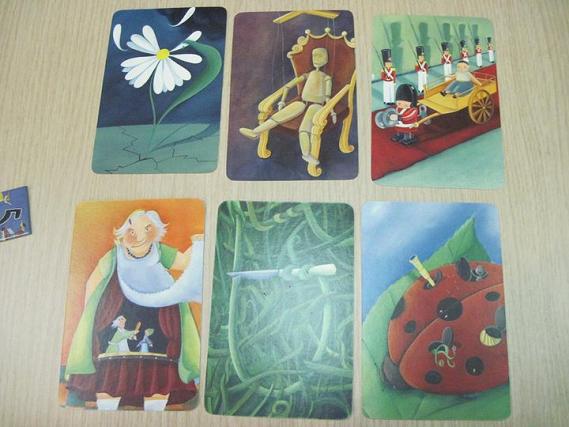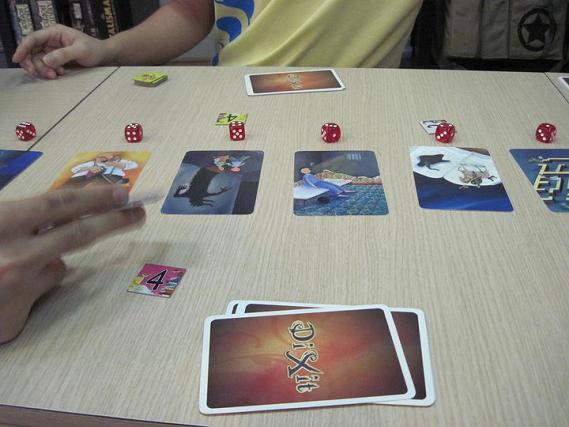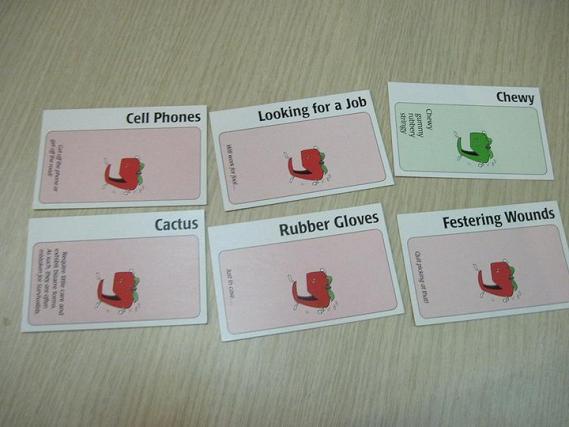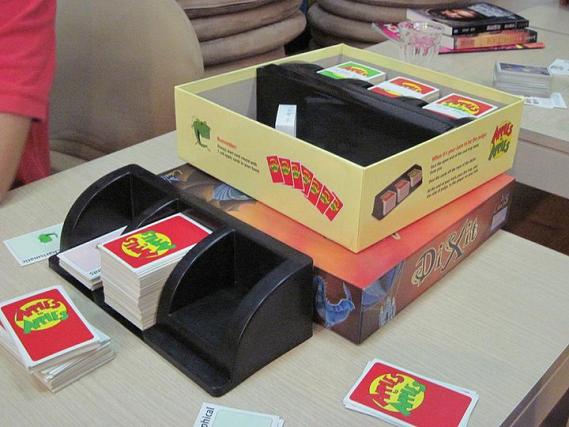
Yes, two party games in one post. As Sean correctly observed, they’re actually quite similar, despite one game being a small deck of cards that show nothing but images and the other one being a ridiculously large collection of cards showing nothing but adjectives or nouns with some explanatory definitions at the bottom. If you like one of them, you’re apt to like the other. I’ll start with Dixit as that was what we played first.
Dixit first came to my attention when it was announced as the winner of the Spiel des Jahres competition for 2010. Naturally I went to BGG to check it out and was amused that the rules could be explained in only a couple of paragraphs. I didn’t think much of it as party games aren’t really my strong suit and so I was less than enthusiastic when it was chosen by our group of six. But by the end of the game I became a convert and was sorry that the game comes with so few cards.
In this game, each player is dealt a hand of six cards, each of which depicts a painted image and nothing else. Each turn, one player is designated the Storyteller. This person chooses one of the cards in his hand and plays it out face-down while giving the other players a clue about what it is, which can be a phrase or just a word. The other players then all pick one card each that they think fits the clue best. After shuffling all these cards, the Storyteller lays them all out face-up and all the other players must then secretly choose the card that they think belongs to the Storyteller.

Once that’s done, everyone reveals their picks and who owns which card. If nobody or everybody picks the Storyteller’s card, everyone except the Storyteller gets 2 points who himself gets 0. Otherwise, the Storyteller and all players who correctly identified his card get 3 points each. In addition, players who aren’t the Storyteller but get their card picked earn 1 point for each other player who chose his card. Then each player is dealt a new card to add to their hand and the next player in turn becomes the Storyteller. The game ends when the deck runs out of cards.
As the Storyteller, naturally the ideal result is to get just one other player to guess correctly. In our game, I tried to be a bit too clever and used “Pan’s Labyrinth” as the clue as I doubted that many others around the table had watched the film. The card I had depicted a dinner table spread, representing what I thought of as one of the most iconic scenes from the film. But one new player briefly summarized the contents of the film to the others and another player offered a baby around dark woods image that most people, including my wife, looked more appropriate, so I was foiled.
Since the others had played the game before, one approach they developed was to name boardgames as clues. Chee Wee gave the clue “Lupus in Tabula” which made things very easy for those who knew which game he meant. Aaron used generic clues such as “beautiful scenery” or “I am happy”. This sounded lame but actually worked quite well. Doing this, you’re basically forcing players to guess but as this strategy article notes, with enough players, at least one player is bound to guess correctly and this is exactly the result you want. I’d consider this against the spirit of the game however.

The game’s biggest fault is that it only comes with 84 cards, which isn’t really enough for 6 players. Under the official rules, most players will only get to be the Storyteller once which is probably the best part of the game. Even with five players, each player will get to be the Storyteller only twice. Sean complained that as you see the same cards over and over again, it becomes harder and harder to find novel clues for them when you play with the same group of people, but I think that this added challenge just makes the game more fun as it will force players to be ever more creative.
After that, we tried Apples to Apples which Sean suggested rather than play Dixit again. The edition of the game that Sean had contained some 1000 cards. Approximately one third of these cards are adjectives. These are called the Green Apples. The rest are nouns, which can be a generic object, such as the Ocean, or a specific person, place or just about anything. These are the Red Apples. Each player is dealt a hand of seven Red Apples while the deck of Green Apples is placed in the middle of the table.
As in Dixit, one player is the designated judge each turn. He turns over one Green Apple card, revealing the adjective. All of the other players must then select a card from their respective hands which they think matches that adjective, at least in the mind of the judge. These cards are all shuffled so that the judge won’t know which card comes from which player. The judge then selects one of these Red Apple cards and awards the Green Apple card to the player who submitted it. The first player to accumulate six Green Apples in this way wins the game.

It was immediately apparent to all that there were no real constraints on what the judge could pick. Sean even announced beforehand that he would pick any nouns related in any way to boardgames regardless of what actual adjective he got. One relatively new player took care to select just the right noun, even taking the time to read the descriptive text to make sure he understood what each one meant. Since the score was public knowledge, there was also some attempt to avoid giving points to players with the highest scores by trying to guess which card he’d played and deliberately passing on it but that was difficult to pull off.
A lot of the fun in this game comes from the humor value of random adjective-noun pairings. With the adjective “cold” out, someone played the card “Dracula” but I won the round with the word “Canada”. Another person played “nasty” and again I won the round with “local police”. Some adjectives were ridiculously easy to match. When my wife needed nouns for “classic” and “dreamy”, all manner of appropriate nouns came out. However, many of the noun cards referred to historical personalities or bits of pop culture that most of the other players found baffling. For example, I had an “Eleanor Roosevelt” card in my hand that I knew was worthless, given the group I was playing with.
Overall while I enjoyed both games, I found Apples to Apples to be a bit too unstructured and random. While neither games should be played with a competitive spirit, I find that the scoring system in Dixit makes it makes it much more game-like and hence for me, fun. It occurs to me that one way to get around the limited cards in Dixit would be to use its rules, but substitute the noun cards from Apples to Apples. You’d lose the ambiguity of the art of course, but clever players could still find creative ways to interpret the words.

Both games turned out to be more fun than I’d expected and Dixit especially won me over. I was dismissive of it at first when I discovered what sort of game had won the award but I now see how it deserved it as a family game. Even after I’d gone home, I kept thinking of inventive ways to devise clues for the cards I’d seen and was disappointed that I only got to be the Storyteller once. The next time we saw him, Sean expressed weariness at being asked to play Dixit over and over again but you can tell from this just how addictive playing it can be.
5 Responses to “Dixit / Apples to Apples”
Dixit does have one expansion. It doubles the number of cards in the game, which puts you in a place where you don’t actually need to use every card every game. It feels a LOT better on repeated play as a result.
Anyway, I’m glad you liked these games! They’re far and away my favorite two party games.
re: dixit. in the game that i played, sometimes some of the other players gave clues based on knowledge / experience that only a subset of players have. i was usually at the receiving end of this and lost out. i don’t like this approach because the players who do not have the knowledge or experience will feel left out, because you know exactly who the storyteller is expecting to know the answer and who won’t know it and have to guess randomly. i prefer hints based on clever twists of words, or abstract ideas / feelings, so that all players are on a level playing field. so when i get to be the storyteller, i give my clues this way. also another aspect is the psychology part. sometimes you can give a clue that is so obvious, some people will hesitate. or you can give a clue that is quite generic, so that chances are someone else will contribute a card that seems like the right answer.
@Hiew
While you’re right, I’m pretty sure that this is how the designers intended for Dixit to be played, for people to think of something that they have in common with a subset of the players present and make a clue based on that. It seems to me that many party games work this way by testing how well you know the people playing with you.
@ Julian
I’m aware that the expansion adds more cards. Seems expensive to me however but I suppose making all that art isn’t cheap.
Yeah, it is a bit expensive for what comes in the package. But like the Shadow Hunters expansion, it actually makes a bigger difference to the playing of the game than it initially appears. Most of my friends that I played just the base game with liked it, but thought it got kinda old after a few plays. As soon as I got the expansion, they did a complete 180. Now, it’s the most consistently requested party game in my repertoire. At the very least, maybe it can make Sean feel a bit better about getting asked to play the game so much.
Trackbacks
Leave a Reply